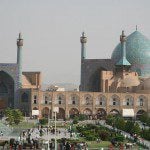
(Wikimedia Commons public domain photo)
***
Back in the first half of 1993, I led a small contingent of fairly advanced undergraduate students of Arabic to East Jerusalem for an intensive five-month language program there. (We also visited Egypt and Jordan.)
One of those students, who has been teaching at Cornell University for quite a few years now, contacted me a few days ago, saying that he and his wife and kids would be in Utah for a few days and wondering whether we might be able to get together for dinner at his in-laws’ house. So we did. And it grew. My wife and I are just back from a very pleasant evening with not only that student but three others, with their wives and at least a significant portion of their children.
It’s astonishing that so many years have passed, that I’m so old now, and that they’re so old. But they’ve turned out solidly well. They’re friends. To each other, to my wife, and even, as inconceivable as it may seem, to me. And it’s reassuring to know that even such a merry group of mad and adventurous madcaps can turn out to be respectable, contributing members of society. We liked them then, and we like them now. Tonight was a treat.
***
John Charlton Polkinghorne, KBE (Knight of the British Empire), FRS (Fellow of the Royal Society), is an English theoretical physicist, theologian, writer, and Anglican priest. He was a professor of mathematical physics at the University of Cambridge until he resigned his professorial chair to study for the priesthood, becoming an ordained Anglican priest in 1982. He served as the president of Queens’ College, Cambridge, from 1988 until 1996.
Here’s a comment from him that I found noteworthy:
“Science has purchased its very great success by the modesty of its ambition. Science does not seek to ask and answer every sort of question. It restricts itself essentially to asking questions of process, which are ‘how questions’ of how things come to be. It also restricts the kind of experience that it takes into account in framing and finding its answers to those questions.”
(Sir John Polkinghorne, “Belief in God in an Age of Science,” in Eric Metaxas, ed., Life, God, and Other Small Topics [New York: Plume/Penguin, 2011, 9])
Sir John’s point is an extremely important one. It expresses one of the reasons why I’m quite unimpressed with people who like to contrast the successes of science with what they see as the lack of such successes in the world of religion.
Tape measures have a very successful record in measuring table tops, bedsteads, driveways, growing children, and women being fitted for dresses.
Literary criticism and philosophical discussions come nowhere near the record of objective success and clarity achieved by tape measures.
Does that demonstrate, though, that tape measures are more valuable and important than performances of Shakespeare, readings of Molière and Goethe and Dante, or discussions of the good, the true, and the beautiful?
No, it simply means that tape measures have been developed (very well) to deal with a severely restricted and well defined sector of the world. Applying a tape measure to a performance of Hamlet, though, or using it to evaluate Goethe’s Faust or Dante’s Paradiso, or to resolve an ethical dilemma, or to judge between Mozart’s “Jupiter Symphony” and “Jupiter, the Bringer of Jollity” from Gustav Holst’s orchestral suite The Planets would be . . . Well, it would be more than slightly mad.
David Aberg’s painting Mother Earth, located in Angelholm, Sweden, measures 86,000 square feet. By contrast, Leonardo da Vinci’s Mona Lisa measures only about thirty inches by twenty-one inches. However, only a loon would pronounce Mother Earth a greater painting than the Mona Lisa on the grounds that it’s demonstrably much, much larger, or because it’s composed of quantifiably more daubs of paint.
***
From the late Elder Richard G. Scott (1928-2015), a nuclear engineer who served as a member of the Quorum of the Twelve Apostles from 1988 until his death:
Try as I might, I am not able, even in the smallest degree, to comprehend the extent, depth, and stunning grandeur of what our holy Heavenly Father, Elohim, has permitted to be revealed by the scientific method. If we were capable of moving outward into space, we would first see our earth as did the astronauts. Farther out, we would have a grandstand view of the sun and its orbiting planets. They would appear as a small circle of objects within an enormous panorama of glittering stars. Were we to continue the outward journey, we would have a celestial view of our Milky Way spiral, with over 100 billion stars rotating in a circular path, their orbits controlled by gravity around a concentrated central region. Beyond that, we could look toward a group of galaxies called the Virgo Cluster, which some feel includes our Milky Way, estimated to be about 50 million light years away. Beyond that, we’d encounter galaxies 10 billion light years away that the Hubble telescope has photographed. The dizzying enormity of that distance is suggested by noting that light travels 700 million miles an hour. Even from this extraordinary perspective there would not be the slightest evidence of approaching any limit to God the Father’s creations.
As awe inspiring as this incredible view of the heavens would present, there is another consideration equally capable of confirming the unfathomable capacities of our Father in Heaven. Were we to move in the opposite direction to explore the structure of matter, we could get a close-up view of a double helix molecule of DNA. That is the extraordinary, self-duplicating molecular structure that controls the makeup of our physical body. Further exploration would bring us to the level of an atom, composed of the protons, neutrons, and electrons we’ve heard about.
Were we to penetrate further into the mysteries of the most fundamental makeup of creation, we would come to the limit of our current understanding. In the last 70 years much has been learned about the structure of matter. A Standard Model of Fundamental Particles and Interactions has been developed. It is based on experimentation that has established the existence of fundamental particles designated as quarks and others called leptons. This model explains the patterns of nuclear binding and decay of matter, but it does not yet provide a successful explanation for the forces of gravity. Also, some feel that even more powerful tools than those used to acquire our current understanding of matter might reveal additional fundamental particles. So there are yet more of Father in Heaven’s creations to be understood by the scientific method.
(“Truth: The Foundation of Correct Decisions,” October 2007)
***
Finally, I close with a quintet of gasp-inducing items drawn from the Christopher Hitchens Memorial “How Religion Poisons Everything” File©:
Presiding Bishop , in the Deseret News: “Perspective: The sustaining power of faith in times of crisis: In times of need, we need spiritual as well as temporal sustenance”
“Italian Woman’s Effort to Help Refugees Gets Help from Latter-day Saint Charities”
“Latter-day Saint Charities and Partners Build New Classrooms for School in Nigeria”
“Lessons Learned From Responding to California’s Wildfires”
And here’s another that I found just to the side of the Hitchens File:
“Cox calls for long-term housing as Utah enters 2nd phase to help Afghan refugees”












